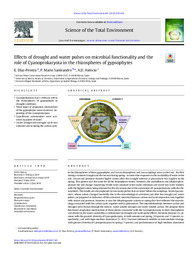Por favor, use este identificador para citar o enlazar este ítem:
https://hdl.handle.net/11000/30574Registro completo de metadatos
| Campo DC | Valor | Lengua/Idioma |
|---|---|---|
| dc.contributor.author | DIAZ PEREIRA, ELVIRA | - |
| dc.contributor.author | Marín Sanleandro, Pura | - |
| dc.contributor.author | Asencio, Antonia Dolores | - |
| dc.contributor.other | Departamentos de la UMH::Biología Aplicada | es_ES |
| dc.date.accessioned | 2024-01-23T12:03:13Z | - |
| dc.date.available | 2024-01-23T12:03:13Z | - |
| dc.date.created | 2019-07 | - |
| dc.identifier.citation | Science of the Total Environment Volume 691, 15 November 2019 | es_ES |
| dc.identifier.issn | 1879-1026 | - |
| dc.identifier.issn | 0048-9697 | - |
| dc.identifier.uri | https://hdl.handle.net/11000/30574 | - |
| dc.description.abstract | In the rhizospheres of three gypsophytes and in non-rhizospheric soil, two samplings were carried out - the first during a summer drought and the second during spring - to detect the responses to the availability of water in the soil. Urease and protease showed higher values after the drought whereas β-glucosidase was highest in the spring. This pattern was the same for all the rhizospheres tested. However, the arylsulfatase and alkaline phosphatase did not change. Surprising results were obtained when water retention and water loss were studied, with the highest values being obtained for the dry season due to the association of Cyanoprokaryota with the rhizospheres. The results are also explained by two water pulses that occurred before the samplings. Several parameters, whose values changed markedly due to the microbiological activation just after the drought and water pulses, are proposed as indicators of this activation: microbial biomass carbon and basal respiration rate, together with urease and protease. However, it was the dehydrogenase activity in spring that best reflected the microbiology associated with the carbon cycle, together with β-glucosidase. The interrelationships between carbon and nitrogen were shown through the indices: water soluble nitrogen and water soluble carbon. We propose three functional adaptation mechanisms of these plants associated with the Cyanoprokaryota in their rhizospheres and related to the water availability as determined by drought and water pulse effects. Herniaria fruticosa is a pioneer with the greatest diversity of Cyanoprokaryota, in both summer and spring (10 species and 11 species, respectively), and with high-medium abundance (5–30%). Teucrium balthazaris exhibits an intermediate strategy, with greater diversity of Cyanoprokaryota in spring (7 species) and predominance of high-medium abundance (5–30%). Finally, Helianthemum squamatum has lower diversity, with one species in summer (with low abundance, <5%) and no species in spring. | es_ES |
| dc.format | application/pdf | es_ES |
| dc.format.extent | 14 | es_ES |
| dc.language.iso | eng | es_ES |
| dc.publisher | Elsevier | es_ES |
| dc.rights | info:eu-repo/semantics/openAccess | es_ES |
| dc.rights | Attribution-NonCommercial-NoDerivatives 4.0 Internacional | * |
| dc.rights.uri | http://creativecommons.org/licenses/by-nc-nd/4.0/ | * |
| dc.subject | Biogeochemical | es_ES |
| dc.subject | Blue-green algae | es_ES |
| dc.subject | Cyanobacteria | es_ES |
| dc.subject | Gypsiferous community | es_ES |
| dc.subject | Gypsiferous community | es_ES |
| dc.subject | Rhizospheric microbiota | es_ES |
| dc.subject | Semiarid environment | es_ES |
| dc.subject.other | CDU::5 - Ciencias puras y naturales::57 - Biología::573 - Biología general y teórica | es_ES |
| dc.title | Effects of drought and water pulses on microbial functionality and the role of Cyanoprokaryota in the rhizospheres of gypsophytes | es_ES |
| dc.type | info:eu-repo/semantics/article | es_ES |
| dc.relation.publisherversion | https://doi.org/10.1016/j.scitotenv.2019.07.145 | es_ES |

Ver/Abrir:
Effects of drought and water pulses (1).pdf
535,56 kB
Adobe PDF
Compartir:
 La licencia se describe como: Atribución-NonComercial-NoDerivada 4.0 Internacional.
La licencia se describe como: Atribución-NonComercial-NoDerivada 4.0 Internacional.
.png)